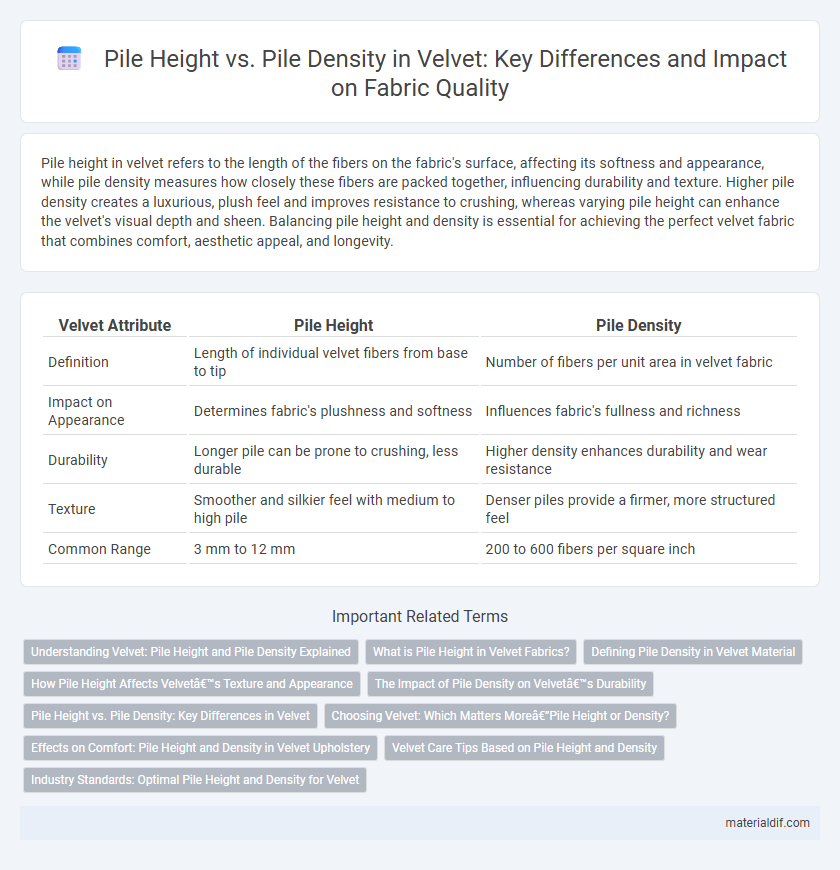Pile height in velvet refers to the length of the fibers on the fabric's surface, affecting its softness and appearance, while pile density measures how closely these fibers are packed together, influencing durability and texture. Higher pile density creates a luxurious, plush feel and improves resistance to crushing, whereas varying pile height can enhance the velvet's visual depth and sheen. Balancing pile height and density is essential for achieving the perfect velvet fabric that combines comfort, aesthetic appeal, and longevity.
Table of Comparison
| Velvet Attribute | Pile Height | Pile Density |
|---|---|---|
| Definition | Length of individual velvet fibers from base to tip | Number of fibers per unit area in velvet fabric |
| Impact on Appearance | Determines fabric's plushness and softness | Influences fabric's fullness and richness |
| Durability | Longer pile can be prone to crushing, less durable | Higher density enhances durability and wear resistance |
| Texture | Smoother and silkier feel with medium to high pile | Denser piles provide a firmer, more structured feel |
| Common Range | 3 mm to 12 mm | 200 to 600 fibers per square inch |
Understanding Velvet: Pile Height and Pile Density Explained
Velvet's luxurious texture is influenced by pile height, which refers to the length of the upright fibers, impacting softness and visual depth. Pile density describes the number of fibers packed into a specific area, affecting durability and richness of color. High pile density combined with optimal pile height enhances velvet's plushness and resilience, making it ideal for upholstery and fashion.
What is Pile Height in Velvet Fabrics?
Pile height in velvet fabrics refers to the length of the raised fibers on the fabric's surface, which directly influences its softness, texture, and luxurious appearance. A higher pile height results in a plusher, more textured velvet, while a lower pile height creates a smoother, more durable finish. Pile height must be carefully balanced with pile density--the number of fibers packed per inch--to achieve the desired tactile feel and durability in velvet upholstery or garments.
Defining Pile Density in Velvet Material
Pile density in velvet refers to the number of fibers packed into a given area of fabric, directly impacting the texture and durability of the material. Higher pile density results in a richer, more luxurious feel and increased resistance to wear, while lower density offers a lighter, airier appearance. Understanding pile density is essential for selecting velvet that balances softness and long-lasting performance.
How Pile Height Affects Velvet’s Texture and Appearance
Pile height directly influences velvet's texture by determining the length of the fabric fibers, with longer pile heights creating a plush, luxurious feel and shorter piles offering a smoother, more refined surface. The appearance of velvet shifts with pile height as longer piles enhance depth and richness of color through greater light reflection, while shorter piles produce a flatter, more uniform sheen. Optimal pile height balances softness and durability, impacting velvet's tactile experience and visual elegance.
The Impact of Pile Density on Velvet’s Durability
Higher pile density in velvet fabrics significantly enhances durability by providing a tighter weave that resists wear and tear over time. Dense pile construction minimizes fiber displacement and flattening, maintaining the fabric's luxurious texture and appearance even with frequent use. This structural integrity makes velvet with increased pile density ideal for high-traffic upholstery and garments requiring longevity.
Pile Height vs. Pile Density: Key Differences in Velvet
Pile height in velvet refers to the length of the individual fibers, affecting the fabric's softness and drape, while pile density describes the number of fibers packed into a given area, influencing durability and texture richness. Higher pile height creates a plush, luxurious feel, whereas higher pile density enhances the velvet's strength and resistance to wear. Understanding the balance between pile height and pile density is essential for selecting velvet suitable for upholstery, fashion, or decorative uses.
Choosing Velvet: Which Matters More—Pile Height or Density?
Pile density in velvet significantly impacts durability and softness, with higher density providing a plush, long-lasting texture ideal for upholstery and luxury garments. Pile height affects the velvet's visual appeal and tactile feel, where shorter piles offer a smooth, sleek surface while longer piles create a rich, opulent look. When choosing velvet, prioritize pile density for wear resistance and comfort, as it ultimately determines the fabric's resilience and quality.
Effects on Comfort: Pile Height and Density in Velvet Upholstery
In velvet upholstery, pile height significantly influences softness and tactile comfort, with taller piles offering a plush, luxurious feel. Pile density enhances durability and resilience, ensuring the fabric maintains its appearance under frequent use. Optimal comfort in velvet combines moderate pile height and high density, balancing softness with long-lasting support.
Velvet Care Tips Based on Pile Height and Density
Velvet with a higher pile height requires gentle care to prevent crushing and matting, making regular brushing with a soft-bristle brush essential to maintain its plush texture. Low pile density velvet, being less compact, benefits from light vacuuming to remove dust without damaging the fibers, while high pile density velvet demands more delicate handling to preserve its rich appearance and avoid fiber distortion. For optimal velvet care, always tailor cleaning methods to the specific pile height and density to prolong fabric life and enhance its luxurious feel.
Industry Standards: Optimal Pile Height and Density for Velvet
Optimal pile height for velvet textiles typically ranges from 8 to 12 millimeters, balancing softness with durability to meet industry standards. Pile density, measured in tufts per square inch, ideally falls between 100,000 and 200,000, ensuring a plush texture while maintaining fabric resilience. These parameters optimize velvet's tactile appeal and longevity, aligning with luxury fabric specifications in upholstery and fashion applications.
Pile Height vs Pile Density (in Velvet) Infographic

 materialdif.com
materialdif.com